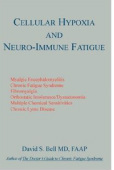
Cellular Hypoxia and Neuro-Immune Fatigue by Dr. David S. Bell is one of the most concise explanations for the mechanisms of CFS/ME that you will ever find. Dr. Bell was one of the first doctors in the U.S. to identify, diagnose and treat patients with CFS, therefore his views on CFS/ME/FM are based on a wealth of experience.
Essentially, Dr. Bell proposes that people with CFS/ME have a slow, chronic form of septic shock. The sequence of events in septic shock is: 1) a serious infection, 2) production of cytokines, 3) increased nitric oxide, and 4) interference with the production of cellular energy. In acute septic shock, the loss of cellular energy is so profound that it can be fatal. In CFS/ME the process is gradual, resulting in vascular problems, neuropathies, and autoimmune processes.
Dr. Bell's theory is that there is a whole spectrum of neuro-immune illnesses which produce cellular hypoxia (oxygen starvation). These illnesses can be triggered by a variety of factors – viral, bacterial, environmental, or CNS trauma. No matter what the trigger, they all lead to a condition in which the body continues to produce inflammatory chemicals, notably nitric oxide. The end result is a hyper-aroused immune response that interferes with the cellular production of ATP, the body's source of energy. This, Dr. Bell believes, is the root cause of the myriad symptoms common to these conditions.
There is a lot of research to support Dr. Bell's position, the most significant of which Bell cites at the end of each chapter. The notion that impaired mitochondrial production of ATP leads to the chronic phase of the illness is not a new one. The first doctor to have pointed out that patients with this disorder might have a mitochondrial defect was Dr. Ramsay, the British doctor who investigated Royal Free Disease in the 1950s. (As Dr. Bell points out, CFS/ME is indeed the disease of a thousand names.) Since that time Dr. Cheney and a host of researchers have amply demonstrated that patients suffering from this illness show defects in the Krebs cycle, the biological process that transforms vitamin C into ATP. Now that we understand the process, the question remains: What does one do about it? For, as Dr. Bell points out "a little bit of vitamin C" is not going to solve the problem.
Dr. Bell, while excellent at explanation, tends to get vague when it comes to practical suggestions that might put his theory to good use. (To give him his fair due, he does state right at the beginning of this book that he will not delve into treatment.) As a consequence, this book might prove frustrating for those who have this illness. But for those who simply wish to understand CFS/ME, Dr. Bell's simple and straightforward explanation will prove invaluable.
Find this book at: http://www.amazon.com/Cellular-Hypoxia-Neuro-Immune-Fatigue-David/dp/1595941797/

 RSS Feed
RSS Feed
